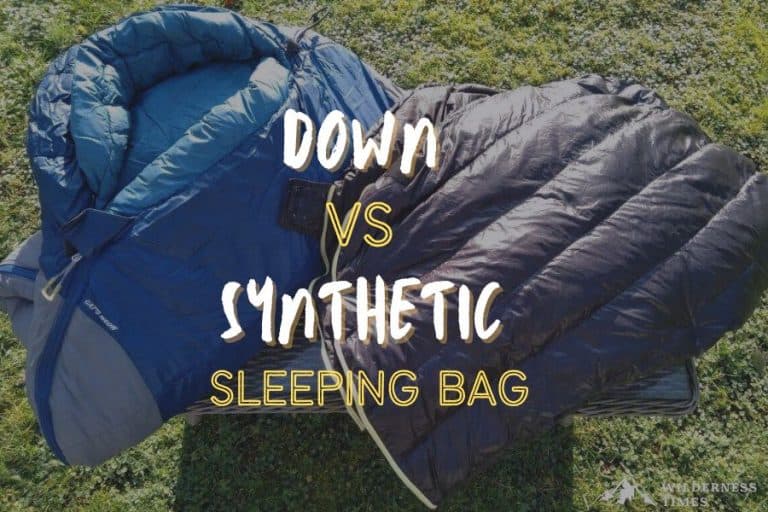Ready to buy a new sleeping bag? There is a lot to consider, but mostly it comes down to down or synthetic and mummy vs rectangular.
As with any other piece of gear, you should do some research before picking the best sleeping bag.
When it comes to down vs synthetic, there is a lot to consider. To help you make an informed decision we’ve put together this quick comparison:
SLEEPING BAG FOR | DOWN | SYNTHETIC |
Fequent Camping | ||
Lightweight | ||
Wet Weather | ||
Cold Weather | ||
Low Maintenance | ||
Longevity |
Read on to learn more about each option!
Table of Contents
ToggleDown Sleeping Bags
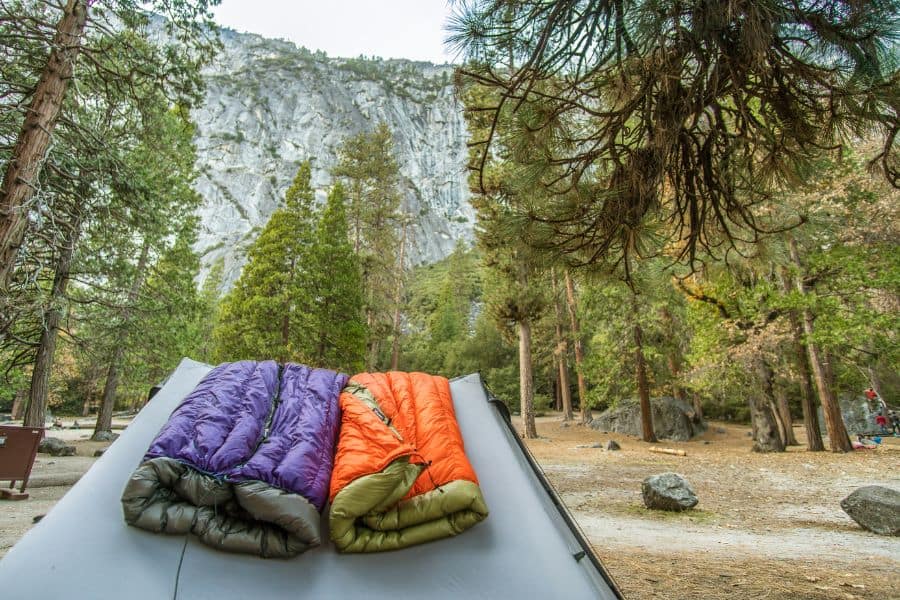
So what is a down sleeping bag anyway?
Well, let’s start by saying what down isn’t. A lot of people believe that a down sleeping bag is filled with bird feathers, but that’s just a misconception.
What is down fill?
Down is actually the soft layer of plumage that’s sitting closest to the skin of the bird, underneath the exterior feathers, mainly in the chest area.
Unlike feather, down has no quills, and it’s extremely fine and fluffy.
What makes down such a popular choice for the sleeping bag fill is its ability to insulate by trapping the air inside.
As long as it’s dry, down can provide insulation in even the harshest weather conditions (and given you have the right temperature rating, of course).
Is down fill lightweight?
We don’t use the word “featherweight” to describe something extremely light for no reason.
A down sleeping bag is a great option for backpackers and thru-hikers, as it doesn’t slow you down.
Generally, a down sleeping bag weighs between one and two pounds.
The history of down insulation
Down has been used as an insulator for centuries, with some written sources dating back to the 1600s.
Back in the day, it was collected by various wildfowl species, as well as gulls and similar seabirds. Today, either duck or goose down is used.
Between the two, the goose is a much larger bird, and the proportions apply in the case of its down clusters as well.
For that reason, goose down is softer and warmer.
Of course, the diet also has an effect on the bird’s down. Ducks will eat anything from lettuce or corn to worms and insects.
And due to some fatty things ducks eat, their down can also contain a high fat amount, which can cause a slight odor.
Geese, on the other hand, usually feed on grass, so the smell of their down is less noticeable.
Down is a food byproduct
What that means is that it’s collected from birds used for food.
And since duck is more commonly used for that purpose compared to goose, duck down is a more economical option.
Now, the actual quality difference between the two types of down is not that prominent.
In fact, most budget and mid-range models will feature duck down.
Goose down, on the other hand, can often be found in premium products.
Advantages of Down Sleeping Bags
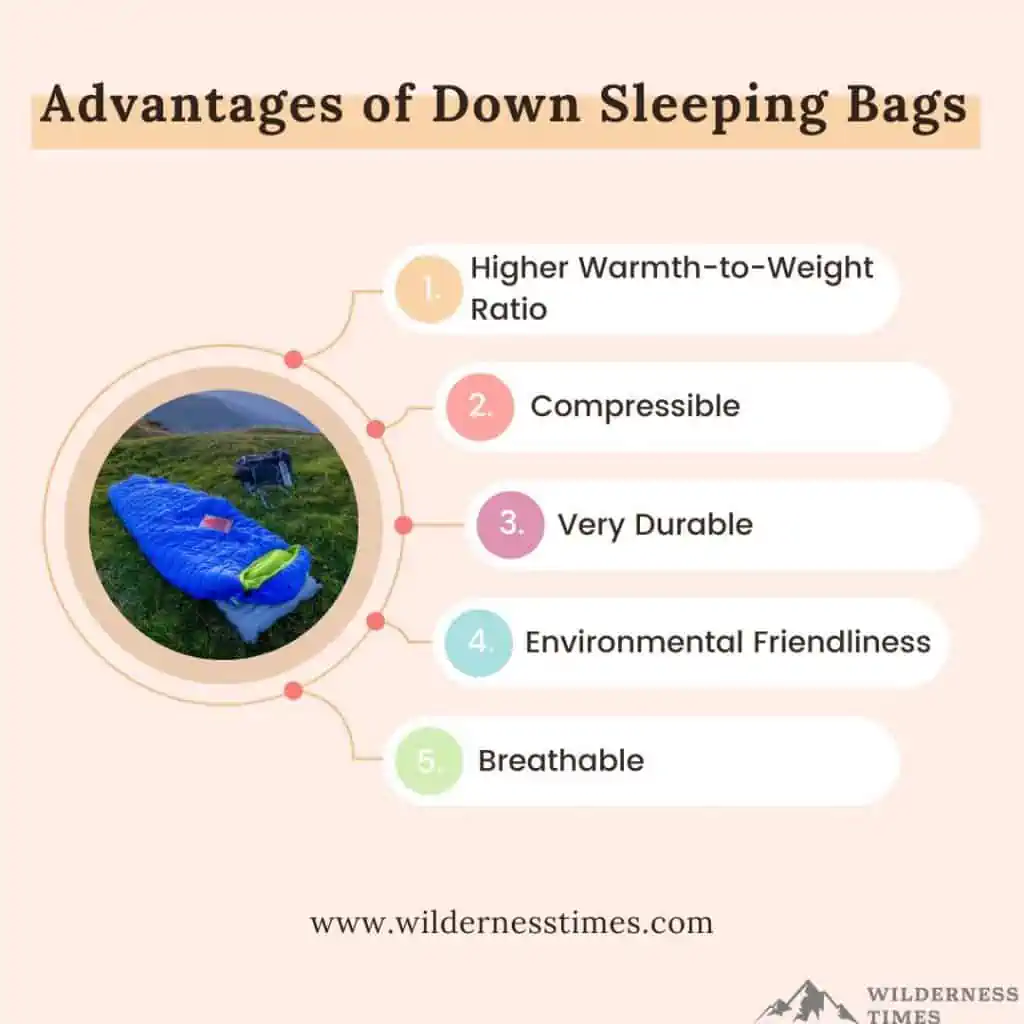
So what makes down so great? These are all the benefits of this type of insulation:
Higher Warmth-to-Weight Ratio
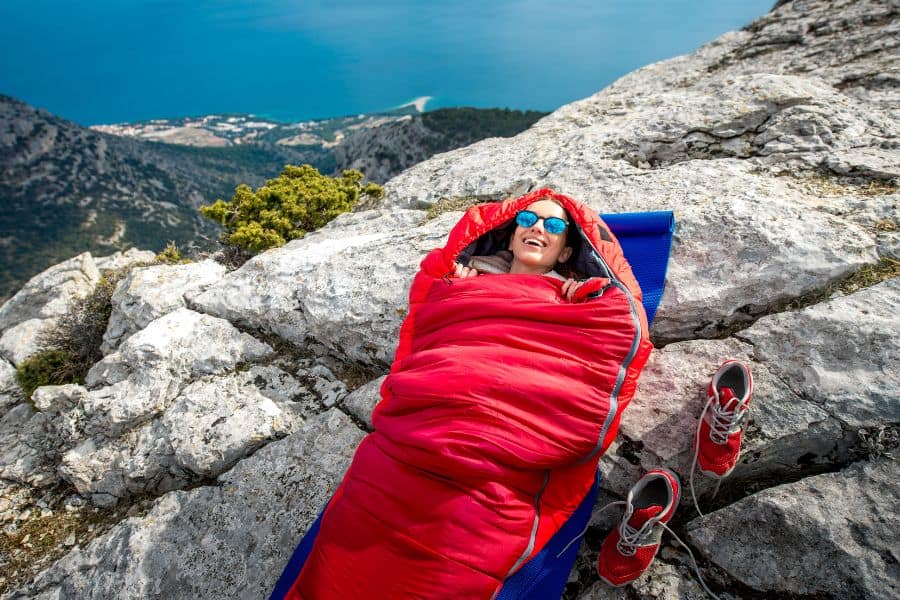
The warmth-to-weight ratio is the measurement used to evaluate the effectiveness of insulation in relation to weather conditions.
And that’s where down shines the best.
Down is extremely lightweight and features fine, branched filaments that trap air in between.
That way, it manages to insulate well without weighing much.
Compressible
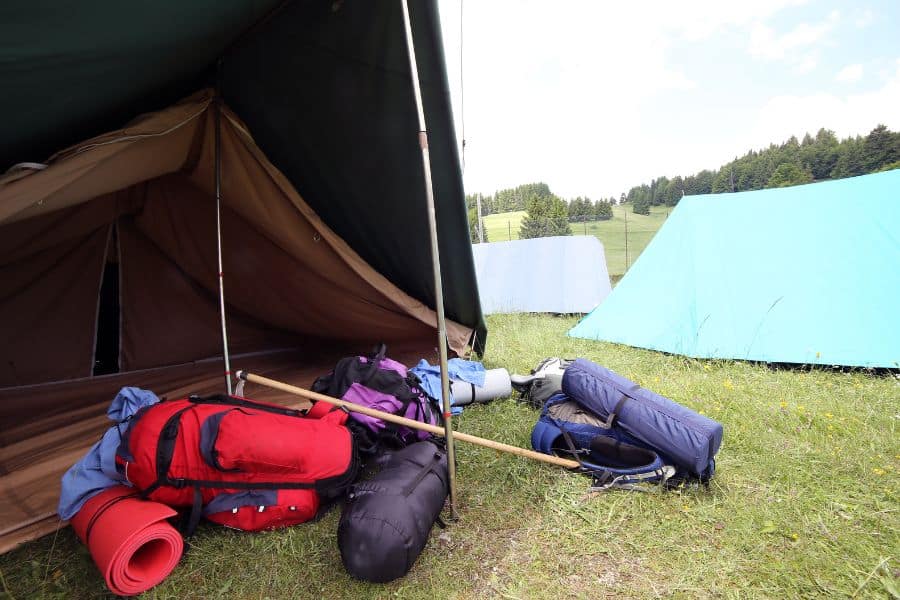
The beauty of down lies in the fact that it’s incredibly compressible.
Its insulating ability relies on the air trapped inside, but you can take that air out when its time for packing.
In fact, a down sleeping bag pack down pretty compact, which makes it great for backpacking.
Now, even though down has great compressibility, you don’t want to keep it stuffed for too long.
When you’re not on the trail, your down sleeping bag should be packed into a much more comfortable bag that allows the loft to expand.
Very Durable
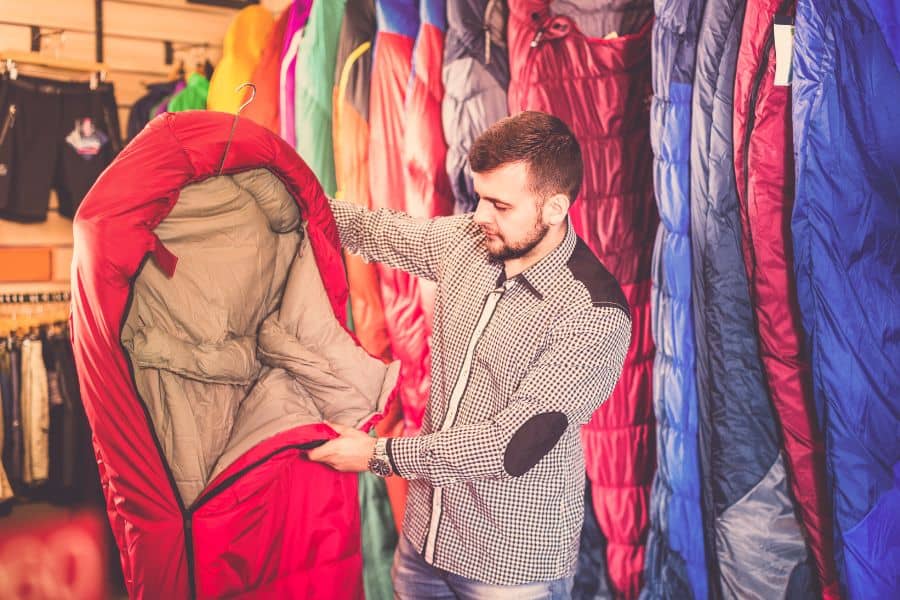
Down is extremely durable. If taken proper care of, a down sleeping bag is something you can pass down to your kids.
With that being said, keep in mind that a down bag can leak over time.
If you see a feather peaking out through the material, just try pushing it back in instead of pulling it out.
Environmental Friendliness
As we already mentioned, down is a byproduct of the food industry. If not collected, it will just end up in a landfill.
But that’s not the only reason why down is a sustainable product.
In fact, compared to polyester, down has up to 97% lower impact on the ecosystem and climate change.
That’s because it’s made with natural fibers that break down completely and doesn’t pollute the planet.
Disadvantages of Down Sleeping Bags
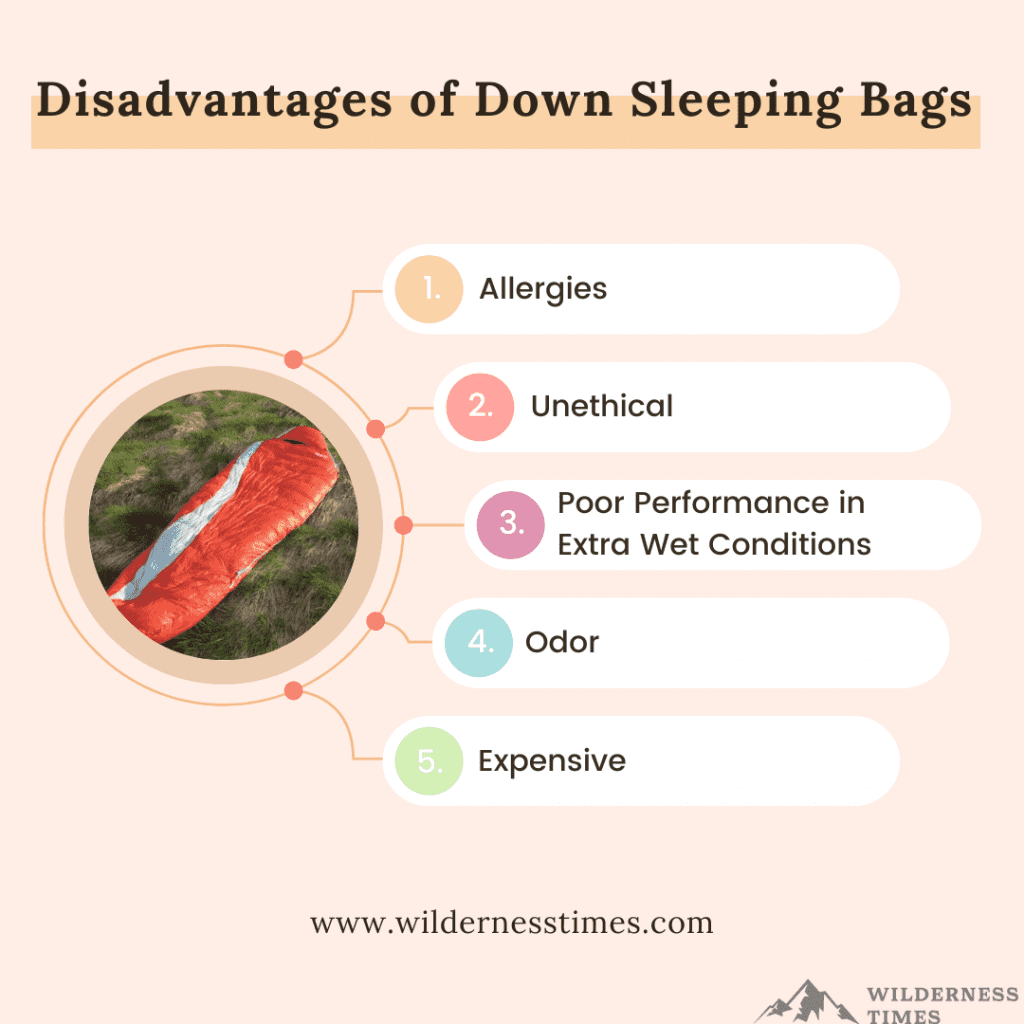
But it’s not all roses with down. There are a few concerns about using this type of insulating material, including:
Allergies

Although it’s really rare, a person can be allergic to down or feather.
If that’s the case with you, the last thing you need is to sleep in a sleeping bag filled with the allergen.
One thing to keep in mind though.
Even though you might experience some kind of allergic reaction to a down bag, that doesn’t necessarily mean you’re allergic to feathers.
In most cases, your allergy is caused by mites found in the product.
The best way to be sure whether you’re allergic to down or not is to do a skin test in a lab.
Unethical
Just because it’s a byproduct, that doesn’t mean that down is ethical material.
For those that oppose the consumption of animal products, that’s not a good enough reason to use down either.
The main issue lies in the ethical concerns related to sourcing.
Unfortunately, there have been a vast number of scandals in recent years related to animal treatment in the food industry.
Live-plucking, which basically involves ripping the feathers off of live birds, is the main concern when it comes to down.
Then, there’s the issue of force-feeding, which results in enlarged livers – the main ingredient in the dish called Foie gras.
Luckily, there are ways down can be ethically sourced these days.
Ethical down has to pass the highest animal welfare standards and only come from birds protected from live-plucking and force-feeding practices.
Poor Performance in Extra Wet Conditions
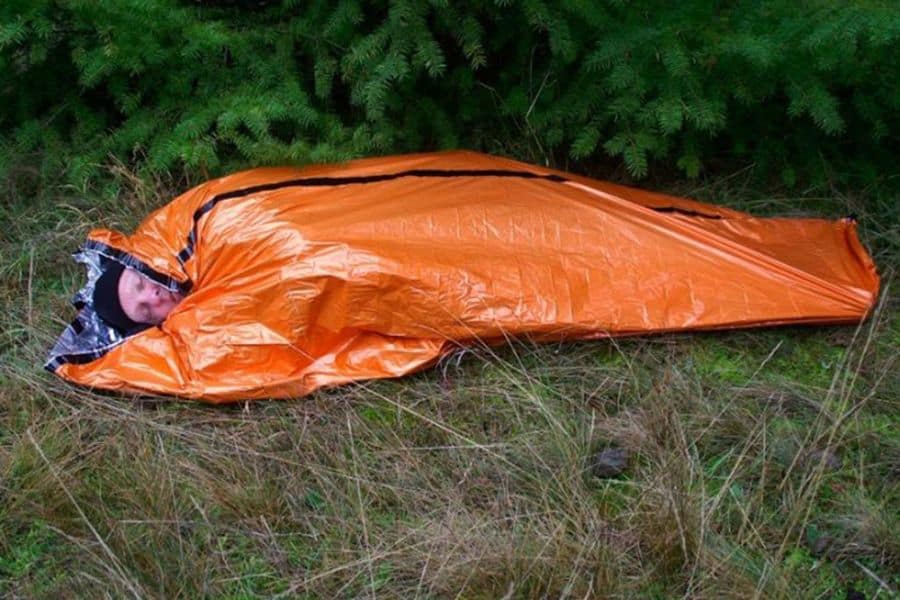
Down provides great insulation – but only when dry. As soon as it gets wet, it loses all its ability to keep you warm.
If you camp in an area with a humid climate, having a down sleeping bag might not be the best option for you.
Odor
Over time, your down sleeping bag can retain odor if you don’t regularly keep up with maintenance.
This usually happens because body oils seep into the material, causing it to clump up from excess dampness.
Aside from creating odor, seeped body oils will also cause the insulating ability of a down sleeping bad to decline.
Final Thoughts On Down Sleeping Bags
A down sleeping bag is extremely lightweight and compressible, which makes it a top option for backpackers and thru-hikers.
If taken proper care of, a down sleeping bag can last you a very long time. We’re talking decades of use, which makes a down sleeping bag a worthy investment.
However, not everything is roses. A down sleeping bag loses its insulating ability when wet, which makes it an unsuitable option for camping in wet conditions.
Furthermore, there are some real concerns regarding the ethical harvesting of down.
Synthetic Sleeping Bags
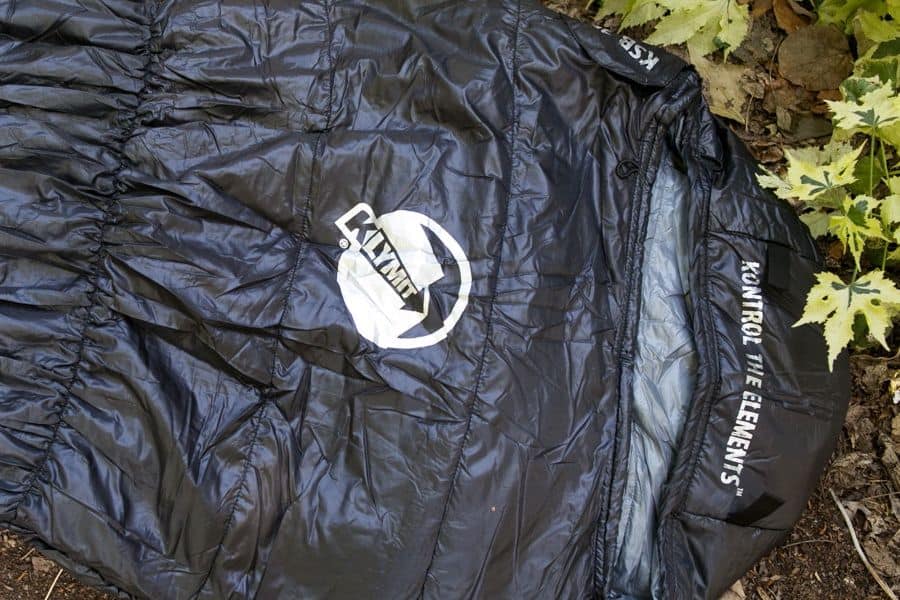
Synthetic sleeping bags are generally made of short strands of polyester fibers, densely packed to prevent losing heat.
Thick continuous filament makes a synthetic sleeping bag slightly stiffer than down, but this also means they don’t create cold spots.
A synthetic sleeping bag offers a good balance of weight, insulation and durability.
They also come in all price ranges, so there’s a product for everyone’s wallet.
Advantages of Synthetic Sleeping Bags
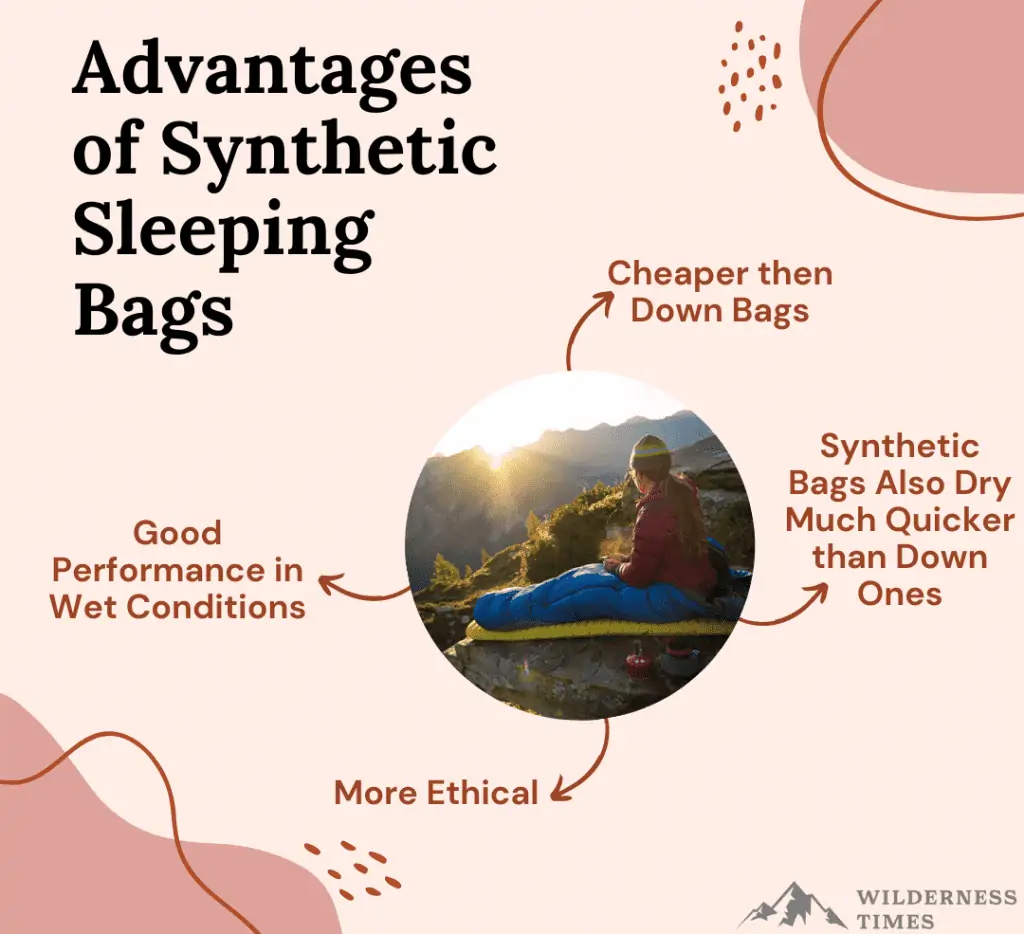
So what makes synthetic sleeping bags so great? Here are the advantages of getting this type of sleeping bag:
Cheaper
Compared to down, synthetic sleeping bags don’t have to break your bank.
What makes them much more affordable than down is the fact that their insulation is produced in a factory, not harvested.
Good Performance in Wet Conditions

What makes synthetic sleeping bags such a popular option is their ability to retain insulating quality even when wet.
Now obviously, that doesn’t mean that a sleeping bag soaked in water will keep you warm and dry. But a slight drizzle won’t be too much of a problem.
More Ethical
We’ve already talked about ethical issues with harvesting down. Well, that’s not the case with synthetic, as it’s created in a factory.
No animals were engaged in the product-making process, from start to finish.
Synthetic Bags Also Dry Much Quicker than Down Ones
Once it stops raining, your synthetic sleeping bag will dry within a few hours at most.
A down alternative, on the other hand, can stay wet for the entire day. If you’re camping in a wet climate, synthetic is, hands down, the best option.
Hypoallergenic
Since it’s man-made, synthetic fiber is designed by mixing materials that can’t cause an allergic reaction.
This makes it a suitable option for everyone, regardless of their health condition.
Disadvantages of Synthetic Sleeping Bags
You guessed it – a synthetic sleeping bag is not without faults.
Heavier and Bulkier
A synthetic sleeping bag relies on keeping the fibers compact to trap heat inside. But more fiber also means more weight.
When comparing a down and a synthetic sleeping bag with the same warmth ratio, the latter will be much bulkier and heavier.
Less Compressible
Synthetic sleeping bags aren’t ideal for backpacking and thru-hiking as they don’t pack very compactly.
Dense fibers don’t allow it to compress the same way a down sleeping bag does. This makes them somewhat difficult to put back into a sack.
Less Durable than Down
Unfortunately, synthetic fibers simply aren’t built to last. And in case you don’t maintain it regularly, their life gets even shorter.
Generally, you can expect to see the signs of breaking down within five to seven years.
Compared to a down sleeping bag, that’s about four times shorter.
Final Thoughts On Synthetic Sleeping Bags
Synthetic sleeping bags are a great option if you’re first time camping.
They are pretty affordable, meaning you won’t have to spend too much money on something you don’t know if you’ll end up liking anyway.
This type of sleeping bag is great if you’re camping in wet weather, as it retains insulation even when wet.
Additionally, it dries down relatively fast, so it will be ready for the night.
Finally, a synthetic bag is great when you’re car camping and not thinking about cutting down weight.
Down/Synthetic Hybrid Blends
As we’ve seen, neither down nor synthetic sleeping bag is perfect. Well, why not get a bit of both instead?
Some brands use a mixture of both synthetic and down to create a sleeping bag that’s lightweight yet affordable.
Of course, it’s impossible to only keep the good and ditch the bad.
But by mixing these two types of insulation together can limit the disadvantages by a large margin.
Sometimes, a hybrid sleeping bag is filled entirely with a combination of both of these materials.
Other times, it’s insulated with down around the head area, while the bottom is entirely synthetic.
Pros:
- Weighs less than synthetic
- Relatively compressible
- Does provide some water-resistance
- Costs less than down
Cons:
- A bit bulkier than a down sleeping bag
- Not as water-resistant as synthetic
- Costs more than a synthetic sleeping bag
Final Thoughts on Hybrid Blends
If a hybrid sleeping bag could retain only the advantages of each of these insulating materials while negating their disadvantages, it would be the perfect product.
The reality, of course, is not that black and white. A hybrid sleeping bag offers a good middle ground for any casual camper.
As long as you’re not traveling long distances on foot and in wet weather, you should be fine with this type of bag.
Down Fill and Insulation Explained
So, how does one know how warm a particular down sleeping bag is?
In case you haven’t noticed, each product features fill power. This number is commonly used to indicate the quality of down.
What is Down Fill Power?
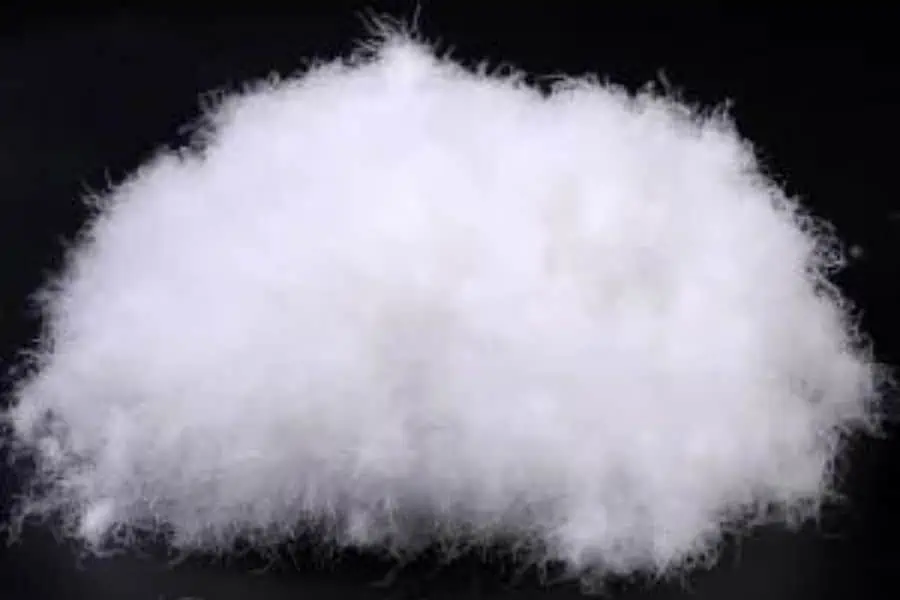
Fill power shows the amount of space an ounce of down can fill, indicated in cubic inches.
To display fill power, we use numbers ranging from 300 to above 900. For high-quality down products, don’t look under 800.
The math behind fill power is simple.
A sleeping bag with a fill power of 500, for instance, doesn’t expand as much to trap air between its filaments as a model with a fill power of 800 does.
However, just because a sleeping bag has a higher fill rating, that doesn’t always have to mean it’s warmer.
That’s because there’s another number we have to take into account – the quantity of down.
So for instance, which one do you think it’s warmer? 500 grams of 450 fill down, or 250 grams of 700? If you answered the first option, you got it right.
With that being said, the more fill a sleeping bag has, the less compressible it becomes. It makes sense, as there’s less air inside to remove when packing.
So if you’re choosing between different down sleeping bags, take both of these numbers into consideration.
But generally, a sleeping bag with lower fill power will be heavier and less compressible than the one with a higher number.
This is something to take into account if you plan on traveling long distances.
Can You Compare Fill Power to Synthetic Fill?
While down insulation is measured in fill power, we use grams per square meter to refer to synthetic fill.
But these two numbers can’t be compared because they don’t show the same thing.
As we already established, down fill power shows the volume of insulation. But with synthetic, we measure its thickness.
Because synthetic fibers are densely packed together, the thicker the insulation, the better it retains warmth.
Comparing two synthetic sleeping bags is rather simple. The higher the number, the warmer it is.
Other Factors to Consider
There are a few other things you should pay attention to when choosing a sleeping bag.
Size/Shape of the Bag
Regardless of what type of insulation you go for, the same thing stands – less empty space inside the bag means it’s warmer.
A mummy style sleeping bag sits snugly around your body, so it’s great for cold weather.
With a rectangular sleeping bag, on the other hand, there’s a lot of room inside that’s filled with air.
And with so much room to wiggle around, there’s so much room to fill with warmth.
Read: Mummy Vs Rectangular Sleeping Bag
Temperature Rating
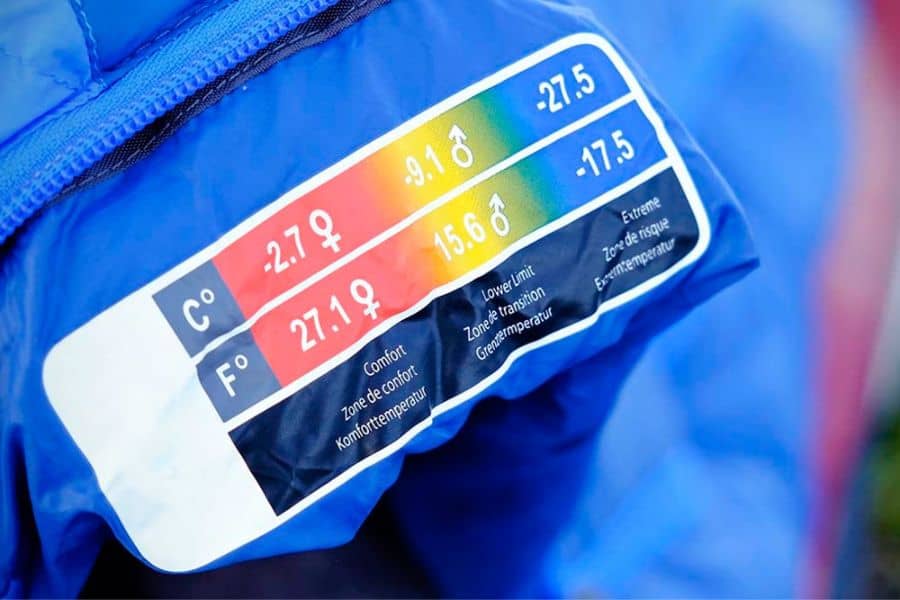
It doesn’t matter whether your sleeping bag is filled with down or synthetic insulation if it doesn’t have the right temperature rating.
Always make sure you’re using a sleeping bag with a rating that’s slightly below the one you’d be experiencing on your camping trip.
You shouldn’t go too low, or else you’ll be too hot to sleep in that sleeping bag. Waking up in a puddle of sweat is never comfortable.
Zips
When choosing a sleeping bag, pay attention to the kind of zippers it has. Metal might appear like a logical option, as it’s extremely durable.
But two metal zippers can actually weigh down your sleeping bag by quite a lot. And in case you’re backpacking, every ounce matters.
Instead, go with plastic or nylon zippers. They’re light but also sturdy, and in case they break, they’re easily replaceable.
Weight
Of course, all of these characteristics above add up to the overall weight of your sleeping bag.
A mummy style sleeping bag has less material, meaning it weighs less.
Generally, sleeping bags with lower temperature ratings will be heavier. This is especially apparent with synthetic insulation.
And finally, the material choice of zippers also weighs down a sleeping bag.
Down vs. Synthetic Comparison Table – Which One to Choose
Still unsure which one is better for you?
Let’s make the decision easier by comparing them in different scenarios.
SLEEPING BAG FOR | DOWN | SYNTHETIC |
Fequent Camping | ||
Lightweight | ||
Wet Weather | ||
Cold Weather | ||
Low Maintenance | ||
Longevity |
Frequent Camping or Backpacking
If you often spend your free time out in the wild, it’s worth investing in durable camping gear. In that case, a down sleeping bag is a perfect option for you.
You’ll also be able to bring that sleeping bag onto an occasional backpacking trip, as it’s so light and easily fits into your backpack.
Occasional Camping
If you go camping no more than a few times a year, then there’s no reason to spend tons of money on something that will sit in your garage for most of the year.
A synthetic sleeping bag is a rather versatile option, as you can use it in both wet and dry weather.
Cold and Winter Weather
If you’re out in extreme weather, staying warm is your top priority. That’s why investing in the high-quality down sleeping bag should be your top priority.
These models usually also feature a water-resistant shell to prevent getting soaked from a bit of snow.
Rainy or Humid Weather
Camping in rainy weather is another story. If you are expecting a lot of rain or humidity, then synthetic is the way to go.
Down becomes useless when wet, and takes a long time to dry, so it’s not ideal for that type of scenario.
Read: How To Choose A Sleeping Bag: Your Guide to Cozy Outdoor Slumber
FAQs
What is the best sleeping bag insulation?
There’s no single best insulation, as they both have their pros and cons. If we’re talking about packability, then down wins by a large margin.
But a synthetic sleeping bag is a more universal option.
Which lasts longer down or synthetic?
With proper and regular maintenance, a down sleeping bag can last you for decades.
Synthetic insulation, on the other hand, breaks down over time. In most cases, their lifespan is from five to seven years.
Why is down expensive?
Down is harvested from live animals, so it’s much more difficult to obtain compared to synthetic, which is produced in a factory.
Do down sleeping bags smell?
Generally, well maintained down sleeping bag should have an odor.
However, if you don’t take proper care of it, down can rot, creating a chemical smell. Plus, this can release certain chemicals that can be harmful to your health.
How to wash sleeping bags (synthetic and down)?
First things first, always check the label for cleaning instructions. But generally, you’re safe to follow these steps.
- Always use a front-loading washing machine. A top-loading machine usually features an agitator and this piece can damage your sleeping bag if it gets wrapped around it.
- If you don’t own a front loading machine, hand wash it.
- With down sleeping bags, it’s always best to use a detergent specially designated for washing down. Regular laundry detergent can cause down to clump up, which will affect its insulating ability.
- Always unzip before washing the sleeping bag. This will prevent zippers from getting snagged.
- Always wash a sleeping bag with warm water on a gentle cycle.
- Rinse it twice to get any detergent residue out of the fibers.
Your bag should feel densely clumped after that. If it appears to be spongy, repeat the rinse cycle.
How do you get the musty smell out of a sleeping bag?
If you don’t dry your sleeping bag completely before packing it up, it might grow mold. And as you probably know, mold doesn’t smell very nice.
Luckily, there’s a way to get rid of the smell at home:
- What you need to do first is unzip the sleeping bag completely to let the air inside.
- Deodorize the bag and leave it in the sun for several hours.
This should kill any mold spores inside the insulation.
In case of moldy stains, a mixture of lemon juice and salt can easily fix that.
- Add about ¼ cup of each ingredient and mix until it turns into a paste. Spread it onto the mold and leave it in sun for several hours.
- Take a dry cloth and brush the paste off.
- Then, dip a toothbrush into a few drops of detergent and scrub the stain away.
- Then, take a damp cloth and clean any residue.
- Moisten two cotton balls with one to two drops of vanilla extract each.
- Place one cotton ball inside the foot of the sleeping bag and the other one inside the center area.
Leave the cotton balls inside the sleeping bag for a minimum of three hours to deodorize any remaining mold smell.
To Sum Things Up
There you have it, everything there is to know about down and synthetic sleeping bags.
Both of them have their pros and cons, so the best option will be something that fits your situation best.
A down sleeping bag is light and compressible, so it’s great for camping trips where packability matters.
It’s relatively expensive, but with proper care, you might never have to buy another one.
A synthetic sleeping bag is an overall good option for casual trips. It works well in both wet and dry weather and it’s relatively affordable.


